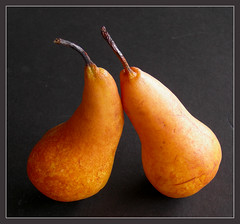Eye-catching and effective, paired adjectives make a colorful splash in 
A page that’s heavy with subject-verb sentences lacks the sparkle that comes from a few well-chosen sentence starters. Used sparingly and appropriately, any sentence variation can spice up an otherwise dull composition.
Paired adjectives keep company with participial phrases, adverbial phrases, subordinate clauses, and prepositions. Most people would agree that each of these lends its own unique flavor to a composition when sprinkled in among the more common subject-verb sentences. But for some reason, paired adjectives in particular have come under fire from some homeschoolers.
What Are Paired Adjectives?
So what’s the big deal about paired adjectives? Well, they’re just one way a writer can add a bit of pizzazz to a piece of writing by mixing up and varying sentence structure. When placed at the beginning of a sentence, this “descriptive duo” modifies the subject that closely follows. For example:
Dark and dank, the narrow tunnel twisted beneath the old castle like an eel.
The twin adjectives dark and dank modify, or describe, the tunnel.
Paired Adjectives Under Fire
Sadly, opponents of the paired adjective seem unwilling to give it a chance. For that matter, they often do not like to see sentence variations taught at all. In fact, they often protest in general about attempts at teaching writing style, believing one’s style ought to come naturally or as a byproduct of reading good literature.
Other critics of the humble phrase would like to see its use banned altogether, particularly from writing programs such as WriteShop, which do teach style. They consider paired adjectives contrived and awkward. When the skill of writing paired adjectives is introduced, they opt to skip the exercise because their children’s efforts sound stilted and unnatural.
New Skills Take Practice
But just because students use paired adjectives incorrectly or immaturely at first doesn’t mean it’s a worthless skill to teach. Think about the first time your kids try something new, like roller skating or baking cookies. Their first attempts are often less than perfect, right?
Consider Nathan, who doesn’t want to skate with the pack until he’s gained more confidence and grace. And Jack’s cookies! Whether bland or burnt, they won’t quite make it to the silver platter the first few times either. But you encourage your children to practice their new skills until they skate like angels and bake cookies they’re proud to serve to Grandma. Isn’t that the nature of learning?
Consider other parallels: Elizabeth begins to experiment with makeup. Her first awkward attempts may make her look severe, but in time she develops a lighter hand for a more natural look.
Similarly, Meghan goes crazy in the kitchen as she adorns her cake with gaudy fluorescent icings and a profusion of candy sprinkles, but soon she learns to create a more appetizing dessert by using softer colors and fewer decorations.
Breaking Free from the Mold
The same holds true for writing. If your student learns “stylistic” techniques through a program like WriteShop, don’t be afraid that he will automatically become an effusive and verbose writer. WriteShop challenges students who live in the land of subject-verb sentences and vague words to try something new, different, and at first, awkward. But over time, WriteShop students DO break free from the mold.
WriteShop does not seek to create wordy and awkward writers. Time has shown that once the strict expectations of the lesson are removed, these kids (many of whom are now successful college graduates) still remember to use an occasional participial phrase to begin a sentence. They use transition words in essays. They’re more alert to passive writing and try to replace overly-repeated words with synonyms. And they even find ways to incorporate paired adjectives in moderation. Thankfully, they do NOT write prescribed and hackneyed five- to seven-sentence paragraphs for the rest of their lives.
My own son Ben, the original WriteShop guinea pig, is now a grad student pursuing a master’s degree in philosophical theology. At first, as a struggling 7th grader, he did write awkwardly. His sentences did sound contrived. But eventually Ben developed his own voice and unique style to become an accomplished writer in his own right. Yet even to this day, he still peppers his papers with those sentence variations and other elements of style he learned ten years ago.
Paired Adjectives in the Real World
Like other sentence variations, paired adjectives help authors add flair and zip to their writing. We’ve gathered an eclectic assortment of quotes from a wide variety of sources to show how real authors, journalists, and marketing experts have used paired adjectives in their own writings. Some of these excerpts come from widely-acclaimed bestsellers. Others have been gleaned from unexpected arenas like department store displays and cosmetics catalogs.
Just as it’s important for kids to see how fractions and algebra relate to the real world, it’s good for your children to realize that the sentences they’re composing for their writing assignments are not futile exercises—they have value and worth and play an important role in all kinds of writing. Encourage your students as they play with words and create sentences, knowing that one day, your fledgling writers will indeed soar.
And watch the blog…I’ll be posting some of these real-life examples of paired adjectives beginning Thursday!
Copyright © 2008 Kim Kautzer. All rights reserved.

